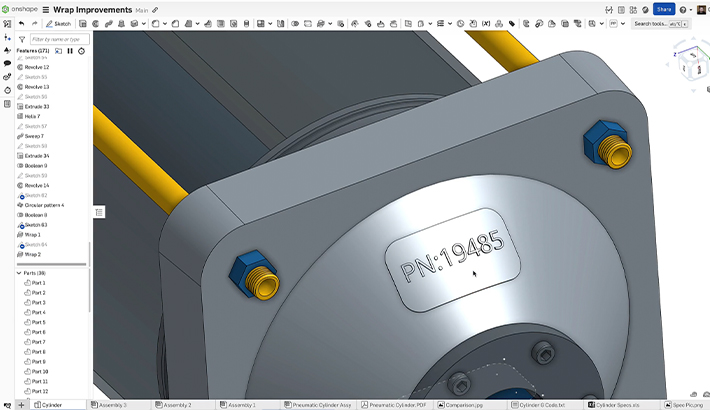Does Your CAD System Enable Remote Collaboration or Prevent Crashes and File Corruption?
The adoption of technology throughout almost every facet of life continues to impact business in unexpected ways. Consumers can order an item they saw online in a matter of seconds and get it delivered to their door. The amount of flexibility given to consumers when ordering online services is unmatched.
Why shouldn’t product development be the same?
The events at the turn of the decade have exposed how vulnerable manufacturing and related industries are when facing unpredictable disruptions, such as labor shortages, tariffs and mandated lockdowns, according to CBInsights. This is in contrast with other industries that were able to accelerate the use of digital tools to meet new demands quickly.
The difference? Manufacturing and product development firms still struggle with legacy technology that inhibits communication, data sharing and collaborating on the same projects.
Product development teams have been forced to work apart and to find new ways to carry on functioning as best they can. For teams using desktop-installed CAD and PDM systems, working together seamlessly has been a challenge. Those without laptops have had to haul their desktop workstations home and take over the kitchen table. Data has had to be shared by email, online file-sharing services, or a VPN to access the office network and the company’s PDM system. This puts a tremendous burden on your employees and your IT staff, and makes it much harder to run your business.
Agile Design and Business Resilience Through Cloud-Native CAD
So what is the way forward? How can you make sure that your business is prepared for any future lockdowns or major disruptive events? How can you minimize the disruption to your business operations and the financial pressures that ensue?
One of the more substantial costs in running a business is to keep the engineering department running at peak efficiency, ensuring that every team member has the tools they need to do their job with the least amount of friction. The reliance on dedicated hardware and the challenge of making company data accessible while keeping it secure has been a problem for many.
Cloud-native CAD tools offer a solution to this problem. Engineers can access the data they need from any device without having to rely on company network access or workstation-class computers. Nobody has to visit the office, nobody has to fight to get the software to work, nobody has to wait to get access to the data they need. Engineers can collaborate in real-time and work on the same project data at the same time. Data is shared, never copied, so you can be sure that your data is secure at all times. Workers can be in the office one day and at home the next without any interruptions.
Now may not feel like the right time to be evaluating new product development solutions. However, the future is unpredictable, and the most pragmatic and forward-thinking engineering companies should be focused on long-term business agility. Any scenario planning must include the provision of a cloud-native CAD system to future-proof your business.
CAD Systems: Comparing Total Cost of Ownership
CAD software installed locally on desktop computers and servers is often referred to as “on-premise” to describe how the software is distributed, installed and used. Typically, when investing in a new on-premise product development tool, the only line items on a software vendor’s quote are the upfront license costs and training. When considering moving forward with your chosen solution, be mindful of the “iceberg effect,” where only the top 10% of costs – the license costs and training – are visible and obvious.
 The Iceberg Effect: The hidden costs of on-premise product development solutions vs. an Onshape subscription.
The Iceberg Effect: The hidden costs of on-premise product development solutions vs. an Onshape subscription.
If you already use on-premise product development software, then you’ll know the total cost of ownership is an order of magnitude higher than that suggested by the software vendor.
The costs involved in managing a team of engineers and their requirements for hardware and software can be substantial. Companies need to manage and maintain multiple servers, networks, firewalls, VPNs, storage, backups, and disaster recovery plans. Facilities require server rooms with adequate power, cooling, fire protection, and physical security. Software needs to be downloaded, installed, configured, licensed, and updated several times a year on each server and every client workstation. All of this needs an army of IT professionals to keep things running smoothly.
If your company operates across multiple sites, continents and time zones, simply multiply all those costs. Implementations take longer and the downtime for maintenance or disaster recovery can halt an entire business.
If you can put actual figures on all those activities, including the number of lost hours per employee and their hourly rates, then you’ll get a true snapshot of what your CAD system is costing you every year. It adds up to a tidy sum.
A quote from a cloud-native vendor can be taken at face value.
Cloud-Native CAD Solutions Save Money
With a cloud-native CAD system, the price is truly the price. Just add the annual software subscription costs and training (if required). What makes the big difference is the delivery mechanism – everything is served from the cloud and accessed through a web browser or mobile device.
Since every device has a web browser, regardless of its specification or operating system, existing hardware in many cases can be utilized without having to invest in the latest and greatest to get the best performance. Backups and upgrades are taken care of automatically with zero IT overhead.
If you search for any online ROI Calculator that compares cloud-native and on-premise software (and there are many, believe me), they report similar results. Some go into a lot of detail and some are more conservative, but they all arrive at the same conclusion: Cloud-native is more cost-effective than on-premise.
The amount of savings you can expect will vary from company to company. Some example figures are detailed here and you can try it out for yourself using your own numbers and Onshape’s ROI Calculator.
Cloud-native tools are being deployed in virtually every other area of a modern business to streamline operations, including sales, marketing, finance, and HR. So why not product development?
To learn how Onshape can reduce your overhead, improve your product development processes, and give you a competitive edge, watch our video “Reducing the True Cost of Your CAD Software With Onshape”.










